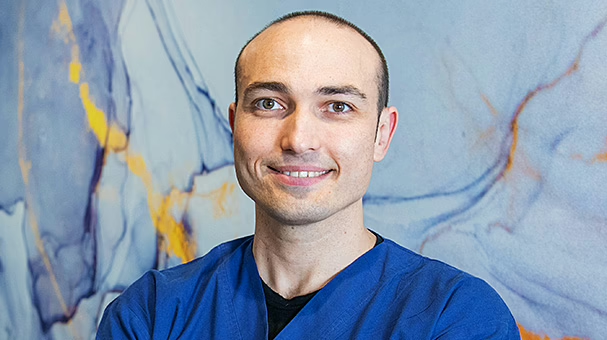Diagnosing diabetic retinopathy
(including diabetic macular oedema)
Your ophthalmologist will examine both retinas after using eye drops to widen your pupils and allow a clear view of the back of each eye.
Other tests that may be performed include:
- Optical coherence tomography (OCT), which is similar to an ultrasound. This provides detailed images of the various tissue layers that make up the retina to help identify and measure any swelling.
- Fluorescein angiography (FA), which involves fluorescent dye being injected into the bloodstream (normally through a vein in your arm) to highlight the blood vessels in the retina. The dye will show any leakage, bleeding or abnormal growth of blood vessels.
Treating diabetic retinopathy
(including diabetic macular oedema)
Various treatments are available and vision can often be at least partially recovered. The earlier the condition is diagnosed and monitored the better, as this provides the best chance of preventing severe vision loss and/or recovering vision. Earlier stages of damage require more frequent monitoring, while treatment is necessary for sight-threatening disease.
Your ophthalmologist will explain your options and recommend an appropriate course of treatment. As with all medical and surgical procedures, these treatments carry risks (although they are rare). It’s important to weigh these risks up against the potential benefits. Your ophthalmologist will help you make an informed decision.
Eye injections
These are also referred to as intravitreal injections and involve injecting medication into the vitreous (the gel-like substance that occupies most of the space inside the eye and gives it its round shape). The medication reduces fluid and swelling in the retina by shrinking abnormal blood vessels and inhibiting growth of new blood vessels.
There are two types of injections:
- Anti-VEGF injections: When cells are deprived of oxygen, a protein known as vascular endothelial growth factor (VEGF) is released. Low levels of VEGF are normal, but high levels of this protein can cause the growth of abnormal blood vessels. Anti-VEGF drugs block the action of this VEGF protein and stop these abnormal blood vessels.
- Steroid injections: Corticosteroids have anti-inflammatory properties and are used to treat a number of conditions. When injected into the eye, corticosteroids can reduce the inflammation that occurs with diabetic retinopathy, central retinal vein occlusion and postoperative macular oedema.
Patients are given anaesthetic eye drops prior to the injection – you may feel some pressure but no pain and you won’t see the needle coming towards your eye because it is given from the side.
These injections are initially administered monthly, usually for about six months or until the condition has resolved sufficiently. Sometimes, ongoing injections are required, but the interval between injections can be extended.
Complications from eye injections are rare, but may include:
- Infection
- Bleeding in the eye
- Retinal detachment
- Cataracts
- Persistent high pressure in the eye
- Allergy
- Inflammation of the eye
Retinal laser treatment
Laser treatment (photocoagulation) uses heat from a laser to seal or destroy leaking blood vessels. It is also used to destroy sick retinal tissue that is no longer functioning properly and is instead encouraging the growth of the abnormal blood vessels. Sometimes, laser treatment is used to reduce swelling at the macula. A special microscope known as a slit lamp is used together with the laser to perform the procedure.
Anaesthetic eye drops are given to numb the eye. A special lens is placed in contact with the surface of the eye to help focus the laser beam. You may feel a slight stinging sensation and see brief flashes of light when the laser is applied to your eye.
Someone will need to drive you home from the clinic after the procedure. Your eyes will remain dilated for a few hours afterwards, therefore it is important to wear sunglasses to keep bright light out of your eyes. Your vision may be blurry and your eye may be uncomfortable for a day or two following the treatment.
Complications of retinal laser treatment include:
- Mild loss of peripheral vision (usually less than if the retinopathy is not treated)
- Reduced night vision
- Decreased ability to focus
Rarely, there may be bleeding, retinal detachment or an accidental laser burn that causes severe central vision loss.
Vitrectomy surgery
Surgery may be required for severe cases of diabetic retinopathy. This involves removing some of the vitreous (the gel-like substance that fills the eye and gives it its shape) and any blood so that light rays can focus on the retina again. Scar tissue from the retina can also be removed and retinal detachments repaired.
Patients are given a local anaesthetic to stop pain and a sedative to reduce anxiety. Following surgery, a pad and shield will be placed over the eye to protect it until you see your ophthalmologist the next day.
Complications of vitrectomy surgery are rare, but include:
- Infection
- Bleeding
- High or low eye pressure
- Cataract
- Retinal detachment
- Loss of vision
Cataracts and glaucoma
While cataracts and glaucoma are more common in people with diabetes than those without, the treatment options remain the same.
Cataracts can be fixed surgically when causing significant visual reduction and sight restored. Learn more
Glaucoma cannot be cured, but the disease can be stabilised. Options include medication (eye drops, tablets), laser treatment and surgery. Learn more
Looking after your eyes
- Make sure you have your eyes checked by an ophthalmologist/optometrist when you are first diagnosed with diabetes. Your eyes should then be checked every 1-2 years, or more frequently if advised.
- Keep your blood sugar, blood pressure and blood cholesterol under control, and have regular health checks to confirm this. While this will not reverse any vision damage that has already occurred, it will help prevent further deterioration of your eyes.
- If you smoke, it’s time to quit. Smokers who have diabetes are at much greater risk of losing their sight, having a heart attack or stroke, and suffering kidney failure.
- Get regular exercise and maintain a healthy diet. Advice from a dietician and your GP is can be extremely helpful.
- Have your eyes checked immediately if you notice any changes in your vision.
- Always take medications as instructed by your doctor.
Clinic team
NSW
-


Dr Christopher Go
BMed MD MPH MMed FRANZCO
Locations
- Drummoyne
- Hurstville
Book a consultationwith Dr Christopher Go
QLD
SA
-

Dr Paul Athanasiov
MBBS FRANZCO MMed (OphthSc) MOphth
Locations
- North Adelaide
- Windsor Gardens
- Kurralta Park
Book a consultationwith Dr Paul Athanasiov
Dr Simone Beheregaray
MD PHD FRANZCO
Locations
- North Adelaide
- Windsor Gardens
- Whyalla
- Brisbane
Book a consultationwith Dr Simone Beheregaray
Dr Soo Khai Ng
MBBS FRANZCO
Locations
- Kurralta Park
- North Adelaide
- Windsor Gardens
- Elizabeth
- Whyalla
Book a consultationwith Dr Soo Khai NgVIC
-

Dr Devinder Chauhan
MBBS MD FRCOphth FRANZCO
Locations
- Boronia
- Box Hill Retinal Clinic
Book a consultationwith Dr Devinder Chauhan
Dr Jeremy Diamond
MB ChB, PhD, FRCS, FRCOphth, FRANZCO
Locations
- Boronia
Book a consultationwith Dr Jeremy Diamond
Dr Eric Mayer
BMBCh PhD FRCOphth FRANZCO
Locations
- Box Hill Retinal Clinic
Book a consultationwith Dr Eric Mayer
Dr John McKenzie
MBBS FRACS FRCOphth FRANZCO
Locations
- Footscray
Book a consultationwith Dr John McKenzie

Dr Christolyn Raj
MBBS(Hons) MMed MPH FRANZCO
Locations
- Blackburn South
- Camberwell
- Coburg
Book a consultationwith Dr Christolyn Raj
Dr Mei Tan
MBBCh BAO PhD FRCOphth FRANZCO
Locations
- Camberwell
- Coburg
Book a consultationwith Dr Mei Tan
Dr Aaron Yeung
MBBCh, PhD, FRCOphth, FRANZCO
Locations
- Footscray
Book a consultationwith Dr Aaron Yeung
Dr Brian Ang
MBCHB FRANZCO FRCOPHTH FRCSED (OPHTH)
Locations
- Blackburn South
- Footscray
Book a consultationwith Dr Brian Ang
Dr Sky Chew
MBBS BMedSc MMed FRANZCO
Locations
- Boronia
- Box Hill Retinal Clinic
- Coburg
- Footscray
Book a consultationwith Dr Sky Chew
Dr Jonathan Goh
MBBS BMedSc PGDipSurgAnat MS FRANZCO
Locations
- Footscray
Book a consultationwith Dr Jonathan Goh
Dr Elvis Ojaimi
MBBS MMed FRANZCO MD
Locations
- Boronia
- Box Hill Retinal Clinic
Book a consultationwith Dr Elvis OjaimiReferences
- Vision 2020 Australia, Diabetes Australia and Centre for Eye Research Australia. The case for an Australian Diabetes Blindness Prevention Initiative. Available from: http://www.diabetesaustralia.com.au/wp-content/uploads/Case-for-an-Australian-Diabetes-Blindness-Prevention-Initiative.pdf (Accessed 15 September 2022).
- Macular Disease Foundation Australia. About diabetic retinopathy. Available from: https://www.mdfoundation.com.au/about-macular-disease/diabetic-eye-disease/about-diabetic-retinopathy/ (Accessed 15 September 2022).
- Kiziltoprak H, Tekin K, Inanc M et al. Cataract in diabetes mellitus. World J Diabetes 2019;10(3):140–153.
- Zhao YX, Chen XW. Diabetes and risk of glaucoma: systematic review and a Meta-analysis of prospective cohort studies. Int J Ophthalmol 2017;10(9):1430–1435.
ResourcesThe information on this page is general in nature. All medical and surgical procedures have potential benefits and risks. Consult your ophthalmologist for specific medical advice.
Date last reviewed: 2025-10-17 | Date for next review: 2027-10-17








